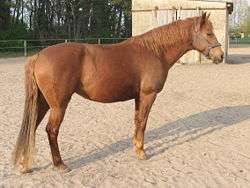Barb horse
The Barb or Berber horse (Berber: ⴰⵢⵢⵉⵙ ⴰⵎⴰⵣⵉⵖ; Arabic: حصان بربري) is a northern African breed with great hardiness and stamina. The Barb generally possesses a fiery temperament and an atypical sport-horse conformation, but nevertheless has influenced modern breeds.
Berber warriors mounted on Barbs | |
| Country of origin | North Africa |
|---|---|
Characteristics
The Barb is a light riding horse noted for its stamina. It has a powerful front end, high withers, short back, a sloping croup, and carries its tail low. It is hardy with clean legs and sound hooves. It does not have particularly good gaits, but gallops like a sprinter. It was used as breeding stock to develop racing breeds such as the Thoroughbred, American Quarter Horse, and Standardbred.[1]
The predominant color is gray, but bay, black, chestnut, and brown horses are also found. The Barb stands 1.47–1.57 metres (14.2–15.2 hands) at the withers.[2]
Breed history
It is not known where the Barb horse developed; some believe the breed originated in northern Africa during the 8th century, about the time that Muslim invaders reached the region. There is controversy over whether the Barb and Arabian horses share a common ancestor, or if the Arabian was a predecessor of the Barb. Native horses of the region may have been influenced by the crossing of "oriental" breeds, including the Arabian horse, Turkoman Horse or Akhal-Teke, and Caspian horse, with Iberian horses brought back from Europe by the Berber invaders after they conquered southern Spain.[3] Today the several varieties of Barb include the Algerian, Moroccan, and Tunisian.
When imported to Europe, the Barbs were sometimes mistaken for Arabians, although they have distinctly different physical characteristics. The Europeans saw that their size was similar and their handlers were Berber Muslims who spoke Arabic. An example of such confusion is that the Godolphin Arabian, one of the foundation sires of the Thoroughbred, was an Arabian stallion but, due to his Tunisian origins, was referred to as the "Godolphin Barb."[4]
The Barb is now bred primarily in Morocco, Algeria, Spain and southern France. Due to difficult economic times in North Africa, the number of purebred Barbs is decreasing. The World Organization of the Barb Horse, founded in Algeria in 1987, was formed to promote and preserve the breed. In 2014, the FEI recognized the Barb horse as their Horse of Honor at the World Equestrian Games in Normandy.[5]
West African Barb
The West African Barb developed from the Barb and is found in West Africa. It is small, most representatives are gray, and the breed is used for both riding and draft work.[6]
Influence on other breeds

The Barb may have had more influence on the racing breeds throughout the world than any other horse except the Arabian.[7] Berber invaders from North Africa took their horses, the forerunners of today's Barbs, to Europe from the early eighth century onwards. Once established with settlers on the Iberian peninsula, the Barb horse was bred with Spanish stock under 300 years of Umayyad patronage to develop the Andalusian (and the Lusitano).[7] The Andalusian was highly prized and it was used for major development stock in horse breeding all over the world.[8]
Historical references to "Barbary" horses include Roan Barbary, owned by King Richard II of England in the 14th century. The Barb horses were valued by other Europeans, including the Italians, whose noble families established large racing stables.[7] During the 16th century, Henry VIII purchased a number of Barbary horses from Federico Gonzaga of Mantua, importing seven mares and a stallion.[7] He continued to buy other Barbs and Andalusians. After the Royal Stables were sold off under Cromwell, private owners in England continued to value the Barbs and used them to develop the Thoroughbred.[7] The influence of the Barb is also evident in the Argentinian Criollo, the Paso Fino, and many other Western Hemisphere breeds, including the American Quarter Horse, the Mustang and the Appaloosa.
Despite its importance as a progenitor of other breeds, the Barb is less renowned than the Arab, possibly because it was considered a less attractive-looking breed. In other important qualities, the Barb has the same stamina and endurance, the same ability to thrive on meager rations, and the same sure-footedness and speed over short distances. The Barb also was valued for its "strong, short-coupled body, perfect for collection— the posture that makes weight-bearing easiest for the horse—its eagerness to learn and its gentle nature."[7] Because of these characteristics, beginning in the 16th century, the horses were also trained for dressage, in Paris and other European capitals. Sixteenth-century and later portraits of royalty on horses frequently portrayed the latter in dressage positions.[7]
See also
References
- Reddick, Kate, Horses. New York: Ridge Press, 1976, p. 60.
- Edwards, Elwyn Hartley (1994). The Encyclopedia of the Horse, London: Dorling Kindersley ISBN 0-7513-0115-9 p.67
- Nissen, Jasper, The Young Specialist Looks At Horses. London: Burke Publishing Co. Ltd, 1963, p. 46.
- Wentworth, Judith Anne Dorothea Blunt-Lytton. The Authentic Arabian Horse, 3rd ed. George Allen & Unwin Ltd., 1979.
- "The Moroccan Barb horse honoured at the Alltech FEI World Equestrian Games™ 2014 in Normandy". horsereporter.com. 2014-04-14. Retrieved 2019-04-06.
- "Breeds of Livestock - West African Barb Horse — Breeds of Livestock, Department of Animal Science". www.ansi.okstate.edu. Retrieved 17 January 2017.
- Jane Waldron Grutz, "The Barb" Archived 2007-06-06 at the Wayback Machine, Saudi Aramco World, January–February 2007, Retrieved 23 February 2011
- Nissen, p. 41.
External links
| Wikimedia Commons has media related to Barb Horse. |
- Aramco World Article - The Barb
- "The Barb or The Berber". http://www.stablemade.com/horsecare/horsebreeds/barb.htm